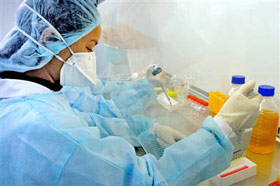A / H1N1 virus spread due to ... negligence in vaccine manufacturing?
Bloomberg news agency quoted Adrian Gibbs, an Australian researcher, who said the A / H1N1 virus could be born during the production of a flu vaccine.
Adrian Gibbs, a 75-year-old Australian researcher, has collaborated on the study of the production of anti-influenza drug Tamiflu at Roche Holding AG, saying he will soon report on the creation of A / H1N1 virus in the past. vaccine production process. Gibbs and his two colleagues relied on genetic analysis to draw this conclusion.
 According to Gibbs, a negligence in the fabrication process facilitates virus variation in laboratory animals (possibly pigs, mammals or a bird) from which to spread around.
According to Gibbs, a negligence in the fabrication process facilitates virus variation in laboratory animals (possibly pigs, mammals or a bird) from which to spread around.
Adrian Gibbs has been a researcher in the field of medicine and health since 1968. He has done extensive research on the evolution of influenza viruses in the past four decades. Gibbs is also one of the first to decode the A / H1N1 influenza virus right after three weeks of outbreaks.
WHO chief of health and environmental security, Keiji Fukuda, received a notice from researcher Gibbs. And Gregory Hartl, a WHO spokesman, said: "It's too early to say anything . " According to Hartl, Gibbs needs to give proof of what he claims. A detailed three-page report is being finalized by Gibbs for submission to the World Health Organization (WHO).
Gibbs's findings give a warning to insecurity in the process of preparing vaccines by scientists. Until now, the most common way to make vaccines is to weaken the virus, the bacteria that cause it to the point of being unable to cause illness or very mild disease, and then into the human body. Thus, the human immune system can identify, "remember", thereby increasing the level of protection more effectively against the real pathogens.
WHO representative today said that influenza A / H1N1 virus appeared in 33 countries and territories, and recorded 5,728 cases of infection.
- Vaccination against H1N1 can cause neurological disorders
- Influenza A / H1N1: Only 1 dose of vaccine is needed
- New treatment regimens can leave H1N1 patients
- Clothes against H1N1 flu
- He gave 'standard' people the vaccine for A / H1N1 flu
- Australia prepares vaccine for influenza A / H1N1
- WHO: A dose of vaccine against influenza A / H1N1 will reach $ 20
- Poor countries have limited access to H1N1 flu vaccine
- New influenza A / H1N1 vaccine: There is no less concern
- Influenza A / H1N1 virus does not
- Novartis began testing the A / H1N1 flu vaccine
- Mumbai closed all schools because of influenza A / H1N1
 Green tea cleans teeth better than mouthwash?
Green tea cleans teeth better than mouthwash? Death kiss: This is why you should not let anyone kiss your baby's lips
Death kiss: This is why you should not let anyone kiss your baby's lips What is salmonellosis?
What is salmonellosis? Caution should be exercised when using aloe vera through eating and drinking
Caution should be exercised when using aloe vera through eating and drinking